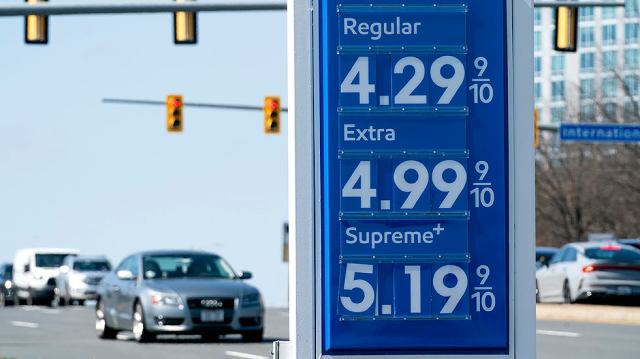
The price of gasoline continues to swell, and a trade group says that uncertainty is hampering the deployment of clean energy.
This is Overnight Energy & Environment, your source for the latest news focused on energy, the environment and beyond. For The Hill, we’re Rachel Frazin and Zack Budryk. Subscribe here.
What’s up with gasoline prices?
Prices at the gas pump are rising yet again as refiners turn to producing jet fuel and diesel instead of gasoline.
Prices across the country were already high before the most recent jumps. Russia’s invasion of Ukraine hit oil markets and global gas prices hard, driving up the price at the pump as governments turned away energy supplies from Moscow.
The current situation: But prices are now going higher, and averaged $4.52 per gallon on Tuesday, according to the American Automobile Association. That’s up more than 40 cents from a month ago, when prices stood at $4.08.
Much of the most recent jump has come just in the past few days as prices rose about 15 cents from a week ago.
Much as high gas prices colored the elections of 2008, when GOP vice presidential nominee Sarah Palin railed on Democratic energy policies, today’s prices are roiling this year’s political debate. Republicans are faulting President Biden’s policies, while Democrats are targeting companies for alleged price gouging.
But why? Experts say the latest jump is linked to a variety of factors including fewer oil refiners making crude oil into gasoline.
Prices of both diesel and jet fuel, which are also made at refineries, are spiking, and experts say many refiners are turning toward making those more profitable products.
“With the market currently really tight both in diesel and jet fuel, we’re actually seeing refineries choose to make less gasoline in favor of those more profitable molecules,” said Matt Kimmel, a senior research analyst for refining and oil markets at Wood Mackenzie.
Patrick De Haan, head of petroleum analysis at gas price app GasBuddy, said that even prior to the latest setbacks, recent refinery closures diminished the country’s ability to produce gasoline.
- In 2019, a refinery in Philadelphia caught fire
- In 2020 a Canadian refinery closed because of COVID-19, and it has since been announced that it will convert into a biofuels operation
- Last year, a refinery in Louisiana closed after flooding related to Hurricane Ida
“The U.S. has now a million barrels a day less of refining capacity than we did in 2019 at a time when we need every barrel of capacity,” De Haan said.
Read more about the price situation here.
Renewables group: Uncertainty delays deployment
Regulatory uncertainty could restrain the growth of the renewable energy industry in the coming years, according to a trade group’s annual report.
In its 2021 report, released Tuesday, the American Clean Power Association said about 10 gigawatts (GW) of the renewable energy capacity set to go online last year was delayed.
“Looking into 2022 and beyond, inflation, supply chain issues, and the uncertainty of tax policy and lack of predictable regulatory action for renewable energy are all expected to have a concerning impact on our ability to deliver growth,” the report
stated.
The report comes as the future of Democrats’ spending bill, which would have created significant tax incentives for clean energy, remains uncertain.
The report also pointed to the likelihood of continued uncertainty within the industry, specifically citing the ongoing Commerce Department investigation into potential tariff circumvention by Southeast Asian solar panel part manufacturers. The Solar Energy Industries Association, the solar industry’s primary trade group, has reduced its installation projections by half in response to the investigation.
The trade group attributed the delays to a combination of lack of policy clarity, interconnection backlogs and supply chain problems.
Read more about the report here.
ON THE FARM (BILL)
A newly formed coalition is pushing to ensure that the 2023 farm bill focuses on regenerative agriculture, a practice that advocates say improves soil health, reduces harmful emissions and transforms small farms into profitable businesses.
Regenerate America, a collection of farmers, environmental groups and companies including Ben & Jerry’s, Vans and Applegate Farms, launched a campaign Tuesday urging Congress to help farmers transition to practices that restore the nation’s rapidly eroding soil.
So what is regenerative ag? Regenerative agriculture involves a variety of tactics, including livestock integration, composting, crop rotation, cover cropping and avoiding or limiting the use of tilling and pesticides.
The coalition warns that U.S. farmland is losing 5.6 tons of topsoil per acre each year, degradation that it says makes for smaller and less nutritious yields and will eventually pose a threat to the nation’s food security.
Advocates are stressing that regenerative agriculture improves yields and reduces farmers’ input costs, which have risen dramatically over the last year. The practice limits the use of industrial fertilizer, which has seen its price spike after Russia, the world’s top fertilizer exporter, invaded Ukraine.
“This is really an opportune moment we have to take a bipartisan approach to something that solves a lot of our crises, but also allows farmers to get out of the hamster wheel of debt and stop increasing their input costs every year,” said Finian Makepeace, co-founder and policy director of Kiss the Ground, an advocacy group leading the coalition.
Makepeace said that some farmers are reducing their input costs by 30 to 40 percent within two years of implementation. But he noted that most farmers don’t have the expertise to carry out regenerative agriculture or the money to pay for the necessary equipment.
So what do they want? Regenerate America is lobbying lawmakers to dedicate 5 to 10 percent of the farm bill’s funding toward incentivizing regenerative agriculture through education, funding and technical assistance. The last bill, enacted in 2018, only committed about 1 percent of its $867 billion total toward the practice.
Read more about the push here, from The Hill’s Karl Evers-Hillstrom.
ON TAP FOR TOMORROW
- The Senate Environment & Public Works Committee will hold hearings to examine the President’s proposed budget request for fiscal year 2023 for the Fish and Wildlife Service. FWS director Martha Williams is expected to testify.
- National Park Service Director Charles Sams III and NPS Comptroller Jessica Bowron will testify before the House Appropriations Committee on the president’s fiscal year 2023 budget request for the National Park Service.
- The House Select Committee on the Climate Crisis will hold a hearing entitled “Climate Smart from Farm to Fork: Building an Affordable and Resilient Food Supply Chain.”
WHAT WE’RE READING
- Scientists find new and mysterious DDT chemicals accumulating in California condors (The Los Angeles Times)
- Natural gas prices have already doubled this year. A hot summer could push them even higher (CNBC)
- Push for environmental justice in underserved communities gains traction in Arizona (The Arizona Republic)
- Shut down fossil fuel production sites early to avoid climate chaos, says study (The Guardian)
- Western states turn to homeowners to deflect drought (E&E News)
ICYMI
And finally, something off-beat and offbeat: Yep, another John Oliver
That’s it for today, thanks for reading. Check out The Hill’s Energy & Environment page for the latest news and coverage. We’ll see you tomorrow.
VIEW THE FULL EDITION HERE
















